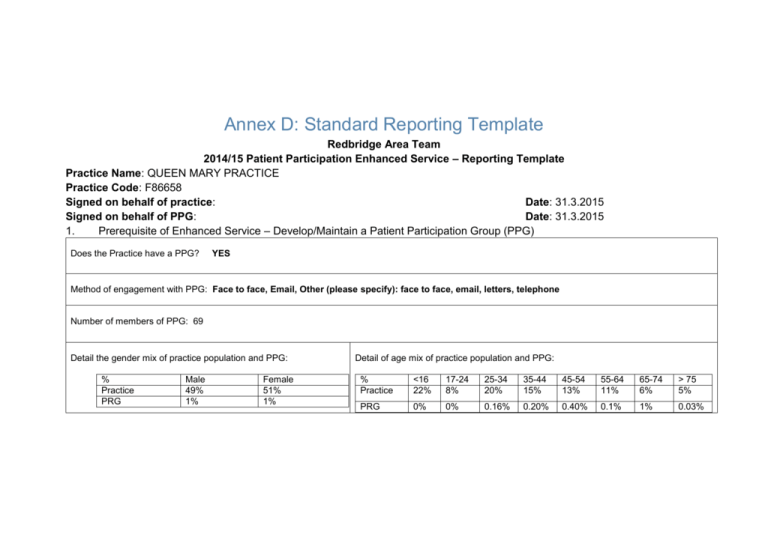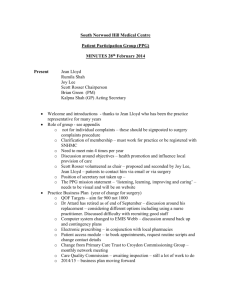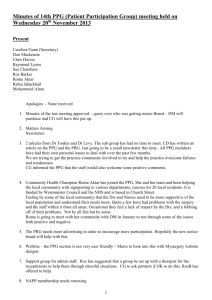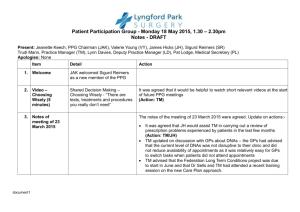PPG Reporting Template Queen Mary Practice Redbridge F86658
advertisement

Annex D: Standard Reporting Template Redbridge Area Team 2014/15 Patient Participation Enhanced Service – Reporting Template Practice Name: QUEEN MARY PRACTICE Practice Code: F86658 Signed on behalf of practice: Date: 31.3.2015 Signed on behalf of PPG: Date: 31.3.2015 1. Prerequisite of Enhanced Service – Develop/Maintain a Patient Participation Group (PPG) Does the Practice have a PPG? YES Method of engagement with PPG: Face to face, Email, Other (please specify): face to face, email, letters, telephone Number of members of PPG: 69 Detail the gender mix of practice population and PPG: % Practice PRG Male 49% 1% Female 51% 1% Detail of age mix of practice population and PPG: % Practice <16 22% 17-24 8% 25-34 20% 35-44 15% 45-54 13% 55-64 11% 65-74 6% > 75 5% PRG 0% 0% 0.16% 0.20% 0.40% 0.1% 1% 0.03% Detail the ethnic background of your practice population and PRG: White Mixed/ multiple ethnic groups British Irish Gypsy or Irish Other White &black White &black White traveller white Caribbean African &Asian Practice 720 35 5 360 16 21 16 PRG 36 2 0 6 0 0 0 Practice PRG Indian Pakistani 330 13 223 4 Asian/Asian British Bangladeshi 98 4 Chinese 37 0 Other Asian 95 0 Other mixed 790 2 Black/African/Caribbean/Black British African Caribbean Other Black 95 58 12 1 1 0 Arab 2 0 Other Any other 790 0 Describe steps taken to ensure that the PPG is representative of the practice population in terms of gender, age and ethnic background and other members of the practice population: At present we have 69members in our group ranging from 27 to 84 yrs old. We have had our PPG members promote the Patient participation Group during clinic times am and pm. This was mainly due to the fact that some patients can only come to the surgery at specific times e.g. those who are working etc hence would be a chance to speak to them about joining the PPG/PRG group We have forms on the website so that patients who cannot come in have access to the forms Posters in the waiting rooms promoting this Display messages on joining the PPG on the Jayex board in the waiting area where patients wait to be called for their appointments Forms to join the group posted with Choose and Book appointments for patients Is part of our New patient questionnaire and all New patients are also offered the opportunity to join the group when they register with us Word of mouth having admin and clinical staff ask patients if they would be interested in joining the group. Forms available at reception. Leaflets offered to all patients attending the practice. M:\PPG\Queen Mary Practice 2013 -2014 PPG Group\PPG 2013 -2014 to be published\PPG poster ILS.doc Are there any specific characteristics of your practice population which means that other groups should be included in the PPG? e.g. a large student population, significant number of jobseekers, large numbers of nursing homes, or a LGBT community? NO If you have answered yes, please outline measures taken to include those specific groups and whether those measures were successful: N/A 2. Review of patient feedback Outline the sources of feedback that were reviewed during the year: A PPG meeting held on 31.7.2014. The members discussed issues that affected them as patients and feedback from fellow patients. The following feedback was given by the PPG: Appointments: Wasted Appointments were discussed and the PPG felt that the DNA (Did Not Attend) rate should be monitored closely. At present the surgery is providing adequate number of appointments but due to the high DNA rate there is a lot of waste of appointments. The patients should be made aware of the waste of resources and how this can be eliminated or reduced. Offering blood testing services in-house to our vulnerable patients. Health Promotion Days: The aim of these services is to educate patients about their condition and help available to them in the community, such as Age UK, Dementia, Diabetes type 1 & 2 awareness, exercise referrals etc. The practice will undertake to organise educational sessions and health promotion days for the patients at the practice. Our PPG members have all opted to help out on the day and also on the organisation of these events How frequently were these reviewed with the PRG? Between 3 and 4 times a year (and whenever our PPG feel it necessary) 3. Action plan priority areas and implementation Priority area 1 Description of priority area: IMPROVING DNA (Did not attend) rate What actions were taken to address the priority? Meeting held with the PPG on 31.7.2014 and one of the areas of discussion was the DNA appointments. High rate of DNA’s Wasted appointments. Wasted clinical and admin time Patients not cancelling their appointments in time to be given to another patient of not cancelling their appointments at all. Encourage patients to use the online appointments as can cancel appointments on line at any time (even when the surgery is closed) Result of actions and impact on patients and carers (including how publicised): Result of Actions and Impact on Patients and Carers: Reduce DNA rate: We now send SMS text messages to patients reminding them of their appointments a day before their appointment. This has helped reduce the DNA rate as patients get a message to remind them of their appointment leading to a better service provided to the patients and also helping in reminding the patients of their appointments. An SMS text message is also automatically sent to those patients who did not attend for their appointments reminding them that they did not attend their appointment and did not cancel it either. This has also prompted patients to cancel their appointments as all the sms messages get recorded on their records. SMS messages are only sent via the system to patients with mobile numbers hence we are also requesting patients for mobile numbers where necessary. If a patient DNA’s continuously then they are sent a 1st, 2nd and 3rd letter informing them of the actions that will be taken by the surgery if they keep missing appointments and this is mainly to avoid abuse of appointments. We also display the number of wasted appointments in the waiting area, so that patients are aware of the number of appointments and the time wasted which could have been used wisely and an appointment given to a needy patient rather than being wasted Patients who suffer from dementia and regularly used to miss their appointments feel this service has reminded them to keep their appointments to an extent. By reducing the DNA rates, it has helped reduce Wastage of appointments: In Dec 2014 we had 92 appointments go to waste. This reduced to 72 appointments in January 2015 after the introduction of the SMS Service. We are robustly collecting mobile numbers from patients as well so that every we can get maximum benefit out of this service. Clinical time: This is a complete waste of time for the clinicians in Dec 2014 1800 hrs were wasted and in Jan 2015 1000 hrs were wasted. Admin time: Writing letters to patients also takes time and is extra work generated when they could be helping a patient, also asking patients to ring back tomorrow for an appointment when they could have give out and appointment an avoid the patient calling back the next day Overall more patient satisfaction as 20 more appointments were given out as above rather than go to a waste. How was this publicised Updated notices in the waiting area for patients for the above showing DNA rates Updated the Jayex notice board messages The website was updated and information added under appointments section, informing patients about the SMS texting and also how to cancel their appointments Priority area 2 Description of priority area: INHOUSE PHLEBOTOMY SERVICE (VULNERABLE PATIENTS) What actions were taken to address the priority? Meeting held with the PPG on 31.7.2014 and one of the areas of discussion was the introduction of in-house phlebotomy service for our vulnerable patients Patients not going in for their blood tests even after they have been given the forms to go for a blood test months ago by the doctor/nurse. Vulnerable patients’ e.g. Patients who are diabetic and need a fasting blood test. At present they are having to go to the hospital for their blood tests and wait for their turn after having fasted the night before. These patients are now given an early slot to come in to have their blood test at the surgery so that they do not have to wait and can go home and eat. Patients with dementia can have their blood test on the same day they come to see the doctor or nurse. Patients over 75 yrs also fall into this category Result of actions and impact on patients and carers (including how publicised): Result of Actions: Impact on Patients and Carers The health care assistant’s clinics have been amended to accommodate the blood test appointments. Patients who find it hard to travel to the hospital etc can now have their blood test at the surgery which is very convenient for them Patients normally have their blood test done on the same day as their visit to the doctor or at their convenience at the surgery mostly patients with Dementia Carers don’t have to make two separate appointments and can have the patient see and blood test done in the surgery on the same day. How was this publicised Updated notices/posters in the waiting area for patients for the above Updated the Jayex notice board messages/ word of mouth The website was updated with the service and also the surgery staff promoting this at reception and in the clinics. Priority area 3 Description of priority area: HEALTH PROMOTION DAY What actions were taken to address the priority? Meeting held with the PPG on 31.7.2014, 10.2.2015 and 30.3.2015 and one of the areas of discussion was the health promotion days for patients at the practice. We decided to do this as a joint project between Elmhurst Practice and Queen Mary Practice as we are based in the same health centre as our goals were the same. Also this kind of event needed a lot of organising and communication with different organisations to see how best they could accommodate us and also as to when they are available to share their services with our patients. To start off we invited a Health watch organisation representative, and Age UK representative to our meeting to update our group their services and also promoter the benefits of their services to our patients Survey was conducted for a month to see if majority of patients would opt for health promotion days, hence helping them to understand their health condition and improve self-management of their medical conditions The survey has also given us and our group a better understanding and idea as to what health promotion clinics are needed to be organised and also distribute how each member of the group was going to contribute to the organisation of the event. We discussed getting in touch with the following groups in our meeting and the meeting up again to see what response we got from each of the groups Local pharmacies Age UK Redbridge Life Health watch Health visitor Practice nurse and doctors. Local gym/exercise & referral. Dementia Redbridge lifeline Patient expert programme Dietician Result of actions and impact on patients and carers (including how publicised): Result of Action and impact on patients and carers We are in the process of organising an open day in April 2015 as the PPG felt it was a better time as it would be spring time and patients are looking at making a change in their lifestyle and health just before summer. (Look good for summer). We have had meetings with the following voluntary organisations to have stalls set up at the clinic. These include diabetes UK, Age Concern, lifeline, sensory services, vision (exercise), and Alzheimer’s society. We are also trying to get the patient expert group on board. We intend to work closely with our local health watch organisation to facilitate this as they are in touch with a few organisations that can help We expect very positive outcome for the carers, including letting them know where they can get help locally, this is an ongoing challenge for the carers of patients we have spoken to. Better understanding of the disease process and the treatment and we expect this to improve their ability to look after them better especially with carers taking care of patients who are on palliative care, are diabetic or have had a stroke etc. This can take a toil on the carers health as well hence were they can go for help is a big issue These open day will also empower the patients to be better equipped to also self-manage their condition The patients will also be aware of all the other organisations and facilities available for them We are hoping to hold another open day in September just before the flu session as well. How was this publicised We have posters in the waiting area informing patients of the open day and the benefits to them The clinical and Admin staff have also been updating patients and handing out slips of the event We have also informed the local pharmacists as they will be taking part in the event to inform our patients who collect their prescriptions as most of the prescriptions are sent electronically to the pharmacy hence the patients will not come to the surgery We will be sending SMS text messages to all our patients nearer the time of the event Progress on previous years If you have participated in this scheme for more than one year, outline progress made on issues raised in the previous year(s): ISSUES RAISE IN PREVIOUS YEAR AND ACTIONS New services offered to Patients: Offered SMS texting, online appointments, Electronic prescriptions, Online prescriptions. GP2GP started for electronic clinical notes of registered patients from their previous practice Promote PPG: Continue promoting and encourage patients of all ages to become virtual or active members via website, leaflets in the surgery, new patient registration, and word of mouth holding stalls at the surgery. Self check in installed at reception for patients to be able to self arrive themselves rather than wait in the queue. 4. PPG Sign Off Report signed off by PPG: YES Date of sign off: 31.3.2015 How has the practice engaged with the PPG: Via email Face to Face For those without email address via telephone and letters How has the practice made efforts to engage with seldom heard groups in the practice population? We feel we have a good representation in out PPG/PRG groups but we continue to: promote our Group to all new patients who join our practice which means all groups of patients have the option of joining our group upon registration and is part of their New Patient Check Our clinicians also promote the group to the patients they see Also promote via posters in the waiting area For those who cannot attend the surgery and would like to be part of the group all forms are available on the website Our reception staff constantly ask patients to join our PPG/PRG and forms available in reception. Has the practice received patient and carer feedback from a variety of sources? YES We receive feedback via our PPG meetings Suggestions and comments box Audits from our computer system (DNA audits) Verbal Feedback from patients seen by the clinicians. We have had good feedback from the Health care assistant who is holding the phlebotomy clinics, as patients say it is much faster and efficient way of getting their blood test NHS choices. Reception staff Practice meetings Friends and Family Survey Was the PPG involved in the agreement of priority areas and the resulting action plan? YES Yes the PPG was involved in all the agreement of the priority areas How has the service offered to patients and carers improved as a result of the implementation of the action plan? DNA’s: The DNA rates have reduced since the introduction of the SMS appointment reminder text messaging and the introduction of the SMS DNA text to the patients. This has encouraged the patients to cancel their appointments on time so that it can be made available to another needy patient, also leading to reduced wastage of appointments. We will continue to obtain mobile numbers from patients for this service to get better results In House Phlebotomy Services: This is also in process and has offered an improved service where vulnerable patients have a choice of where they would like to get their bloods done. We have a least two dementia patients who have benefitted from this service along with the over 75 population Health Promotion Days: Both the PPG and the practice feel these sessions will empower the patients to be better equipped to self-manage their condition and will also give a better understanding to the carer of the person they are looking after. Most patients who need help will have better knowledge of where they can go for social help etc. We hope to continue with this in the future Do you have any other comments about the PPG or practice in relation to this area of work? Our PPG/PRG have been most supportive and have continued to support us with most changes in the practice. They have suggested ways of improving the surgery and also applauded us where we have exhaled in our services. They have helped us steer the health promotion day and have taken an active part to make sure it is a success. We would like to thank our PPG for their continued support.


